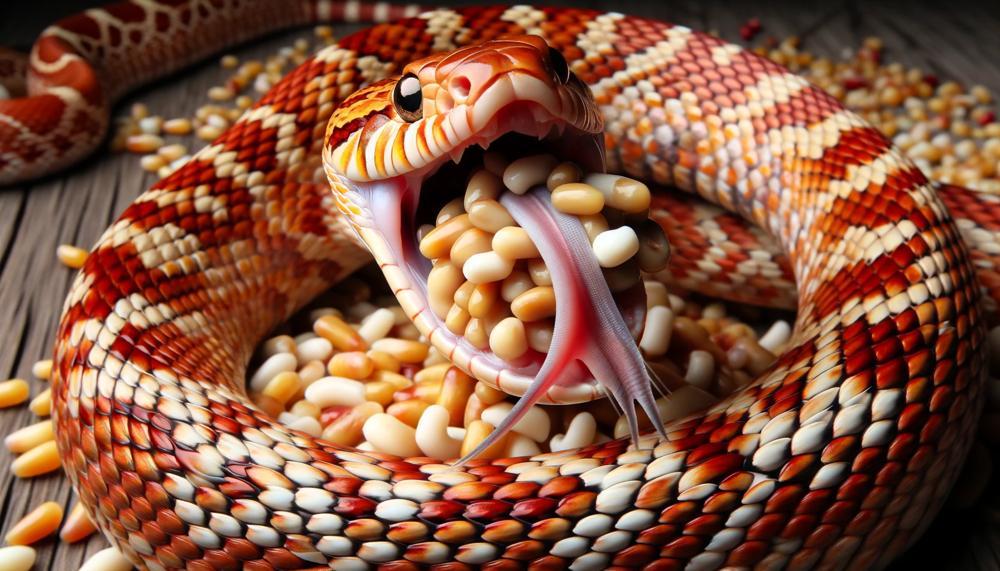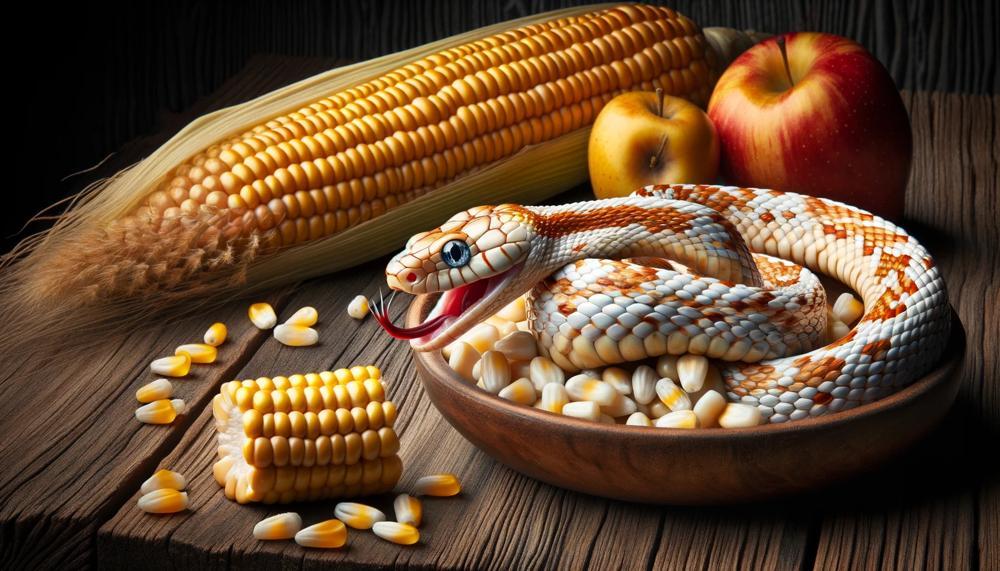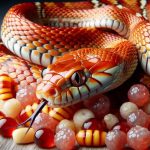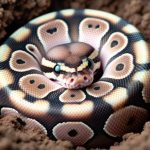Corn snakes, with their mesmerizing patterns and docile nature, are not just popular pets but also remarkable survivors. Their ability to endure extended periods without food is not only a testament to their resilience but also a fascinating aspect of their biology that has intrigued herpetologists and reptile enthusiasts alike.
In this deep dive, we’ll explore the boundaries of survival for these resilient reptiles, shedding light on how long a corn snake can truly go without eating. Here’s what you’ll discover:
- The surprising duration corn snakes can survive without food and the factors that influence this period.
- Adaptations and behaviors that enable corn snakes to endure these fasting periods.
- Practical insights for pet owners on managing feeding schedules and understanding the natural eating habits of corn snakes.
Prepare to be engrossed as we unravel the secrets behind the fasting resilience of corn snakes. Their ability to navigate the fine line between fasting and survival offers a remarkable glimpse into the complex interplay of biology, environment, and instinct that defines the natural world.
Join us as we delve into the heart of their survival strategies, revealing insights that are as engaging as they are enlightening.
Contents
- 1 Corn Snake Feeding Habits
- 2 How Long Will A Corn Snake Go Without Food Before Dying?
- 3 Why Is My Corn Snake Not eating?
- 4 How Long Will a Corn Snake Go With No Water?
- 5 Do corn snakes have teeth?
- 6 Do Corn Snake Teeth break Off?
- 7 How Many Teeth Do Corn Snakes Have?
- 8 Do Corn Snake Bites Hurt?
- 9 Conclusion
Corn Snake Feeding Habits
Corn snakes, with their slender build and vivid patterns, are a sight to behold, especially when they navigate the confines of their enclosure with an air of curiosity and grace.
When it comes to feeding these captivating creatures, the routine isn’t just about tossing in a mouse and calling it a day; it’s about understanding their needs, habits, and how they interact with their environment to maintain their health and vitality.
Frequency of Feeding
The frequency at which corn snakes are fed hinges largely on their age, with younger snakes requiring more frequent meals than their adult counterparts. Here’s a quick glance at their feeding schedule:
| Age Group | Feeding Frequency |
| Baby Corn Snakes | Every 5-7 days |
| Adult Corn Snakes | Every 7-14 days |
Survival Without Food
Corn snakes, much like other reptiles, have an impressive ability to go without food for extended periods. This ability is a testament to their adaptability and the efficiency of their metabolism. Depending on the age and health of the snake, the duration they can safely go without eating varies significantly:
| Condition | Duration Without Food |
| Baby Corn Snakes | Less than 2 weeks |
| Adult Corn Snakes | Up to 2-3 months |
Considerations
It’s crucial, however, to bear in mind that while these snakes can survive without food for quite some time, such periods should not be a regular occurrence. Extended fasting can be indicative of stress, illness, or unsuitable living conditions, especially if it coincides with other symptoms such as lethargy or weight loss. Consulting with a vet is advisable if you notice a prolonged lack of interest in food, irrespective of the snake’s ability to endure without it.
Moreover, the choice of prey, its size, and the method of presentation (live vs. thawed) play significant roles in a corn snake’s willingness to eat. Prey that matches the snake’s mid-body diameter is ideal, ensuring that the snake does not struggle with digestion or potential injury from its meal.
How Long Will A Corn Snake Go Without Food Before Dying?
On average, an adult corn snake can survive without eating for about two to three months before it potentially faces life-threatening conditions. It’s vital to understand, though, that while they can endure this length of time, it’s far from ideal for their health or well-being.
Feeding Patterns and Survival Rates of Corn Snakes:
| Age of Snake | Frequency of Feeding | Survival without Food |
| Juvenile | Every 5-7 days | Less than 1 month |
| Adult | Every 10-14 days | 2-3 months |
| Senior | Every 14-20 days | Up to 2 months |
Why Is My Corn Snake Not eating?
When your corn snake refuses its meals, it’s like a red flag waving at you, signalling “Hey, something’s up.” You see, these slithery pals are typically not fussy eaters. But when they turn their noses up at food, it’s time to play detective and figure out why.
Common Reasons for Loss of Appetite:
- Shedding Troubles: Like getting out of a tight jumper, shedding can make your snake feel irritable and not in the mood for munching.
- Brumation Blues: They sometimes hit the snooze button and slow down for winter, not eating much or at all.
- Stress Factors: New home? Too much handling? These can all send your snake into a no-eat huff.
- Health Hazards: From respiratory infections to belly blockages, health issues can turn their appetite off.
How Long Will a Corn Snake Go With No Water?
A corn snake’s resilience to dehydration isn’t as robust as its ability to go without food. While these serpents can survive for a significant period, typically 2-3 months, without eating, their tolerance for lack of water is considerably shorter.
A corn snake, much like any creature, requires regular hydration to maintain its bodily functions. They generally should not go without water for more than a week. Ensuring consistent access to fresh, clean water is critical for their health and well-being.
Comparison of Survival Durations
| Condition | Duration without Food | Duration without Water |
| Adult Corn Snake | 2-3 months | Up to 1 week |
| Baby Corn Snake | Cannot survive more than a week without food | Less than a week |
| During Shedding | May not eat for 2 weeks around shedding | Requires consistent hydration |
Do corn snakes have teeth?
Yes, corn snakes do have teeth that are sharp and suited for their method of hunting and consuming prey.
Understanding Corn Snake Dentition
Corn snakes, admired for their docile nature and striking patterns, possess around 20 to 30 fine, pointed teeth.
These aren’t your typical chompers; they’re designed ingeniously for grasping and holding. Despite their lack of fangs, they compensate with these slender, sharp teeth, primarily used not for maiming but for securing their soon-to-be meals.
Teeth Structure and Function
These creatures, void of venom, rely on constriction to subdue their quarry. Their teeth play a crucial role in this process, latching onto the prey firmly, ensuring it remains in place while the snake applies its powerful coils.
Think of their teeth as the initial grip in their hunting repertoire – essential but part of a larger, more intricate ballet of predation.
Safety and Handling
For those who fancy keeping these serpents as pets, a bite, albeit rare, is usually no more than a nuisance.
It’s akin to a superficial scratch, yet it’s wise to treat it with care to dodge any unwanted infections.
Table: Corn Snake Teeth Overview
| Characteristic | Description | Implication |
| Number | 20-30 | Adequate for grasping prey |
| Type | Non-venomous, sharp | Effective in holding prey for constriction |
| Maintenance | Continuously replaced | Ensures effectiveness despite brittleness |
Do Corn Snake Teeth break Off?
Indeed, corn snake teeth can break off, yet this seldom poses a long-term issue for the snake. These reptiles are equipped with an ace up their sleeve, or rather, in their gums. When a tooth breaks off, another can grow in its place, ensuring the snake isn’t toothless for too long.
It’s a bit like a shark, albeit on a much smaller and less fearsome scale. The resilience of these creatures is nothing short of remarkable.
Can a Corn Snake Survive Without Its Teeth?
Absolutely, a corn snake can make do without its teeth, at least for a while. These creatures are survivors, adapting to their circumstances with remarkable agility.
However, it’s crucial for their well-being to minimize such occurrences by ensuring they’re not biting on hard surfaces or being handled too roughly.
The Importance of Teeth to a Corn Snake
| Function | Description | Impact of Loss |
| Feeding | Essential for gripping prey | Difficulty capturing and consuming food |
| Defence | Used as a deterrent against predators | Reduced ability to ward off threats |
| Health Indicator | Good dental health reflects overall well-being | Potential sign of underlying health issues |
How Many Teeth Do Corn Snakes Have?
Corn snakes typically boast a collection of around 150 teeth, each playing a vital role in their survival and feeding habits.
Unlike some of their slithery counterparts equipped with venomous fangs, corn snakes employ their numerous small, sharp teeth primarily for securing their prey rather than for delivering lethal injections.

These teeth, all backward-facing, ensure that once dinner is caught, it’s going nowhere, helping the snake to hold onto its meal as it wraps itself around the prey in a constricting embrace, a technique that ultimately leads to the prey’s demise.
The act of swallowing is aided significantly by this unique dental arrangement, allowing the corn snake to consume meals often larger than its head, thanks to its capable jaw.
Here’s a deeper dive into the specifics of a corn snake’s teeth and their functions:
| Teeth Count | Purpose | Structure |
| Approximately 150 | Gripping Prey | Small, Sharp, Backward-Facing |
| N/A | Aiding Digestion | Enables swallowing of large meals |
| N/A | Non-Venomous Bite | No fangs; bites are non-lethal |
Corn snakes are renowned for their gentle disposition, making them beloved pets. Yet, it’s crucial to handle them with care to avoid stress-induced bites, which, while minor, demand proper cleaning to dodge infection.
Their adaptable nature, coupled with a knack for regenerating lost teeth, underscores the corn snake’s resilience as both a wild dweller and a companion animal.
Do Corn Snake Bites Hurt?
When pondering whether a nip from a corn snake might have you yelping in surprise, rest easy. The bite of a corn snake is more a fright than a plight. These serpents, armed with tiny, sharp teeth, aim not to harm but to clutch their dinner. Their bite? A mere pressure, likened to a pinch, rather than a piercing agony. It’s the surprise, really, that gets your heart racing more than the bite itself.
| Aspect | Description | Impact on Humans |
| Biting Force | Mild, with minimal pressure | Low – More startling than painful |
| Teeth Structure | Approximately 150 small, sharp, backward-facing teeth | Mild discomfort – Akin to a brush against a thorny bush |
| Venom | None | No venomous effects – Safe for humans |
Corn snakes, with their docile nature, make splendid companions for those inclined to herpetology. The sting of their bite, should it ever come to that, is fleeting. It’s a brief sharpness, akin to being snapped by a small rubber band, subsiding almost as quickly as it comes. The real bother is the shock, a sudden jolt rather than enduring pain.
Handling these creatures with respect and care not only assures your safety but also their comfort. Remember, a bite is often their last resort, a plea for peace rather than an act of aggression. So, should you find yourself on the receiving end of a corn snake’s displeasure, take it in stride.
Conclusion
The capacity of corn snakes to endure prolonged fasts is an intriguing example of their extraordinary flexibility and durability. These fascinatingly pattern-loving, soft-spoken animals may remarkably survive for two to three months without food as adults; adolescents have a lower tolerance. This amazing accomplishment emphasizes how crucial it is to understand their innate eating patterns and how important it is to maintain a well-managed diet in order to maintain their health and energy.
The article clarifies important factors that pet owners should be aware of, such as feeding frequency according to the age of the snake, the need of giving a proper prey size, and the need to prevent extended fasts that may be signs of stress or disease. It also highlights how vital it is that they have regular access to water, since this is much more critical to their health than their capacity to survive without food.
Fostering a healthy environment that reflects the behaviors and requirements of corn snakes in their native habitat requires an understanding of several areas of corn snake care. The capacity of corn snakes to withstand fasting is evidence of their flexibility, but it also emphasizes the need for pet owners to give their animals with a loving and careful care routine.






